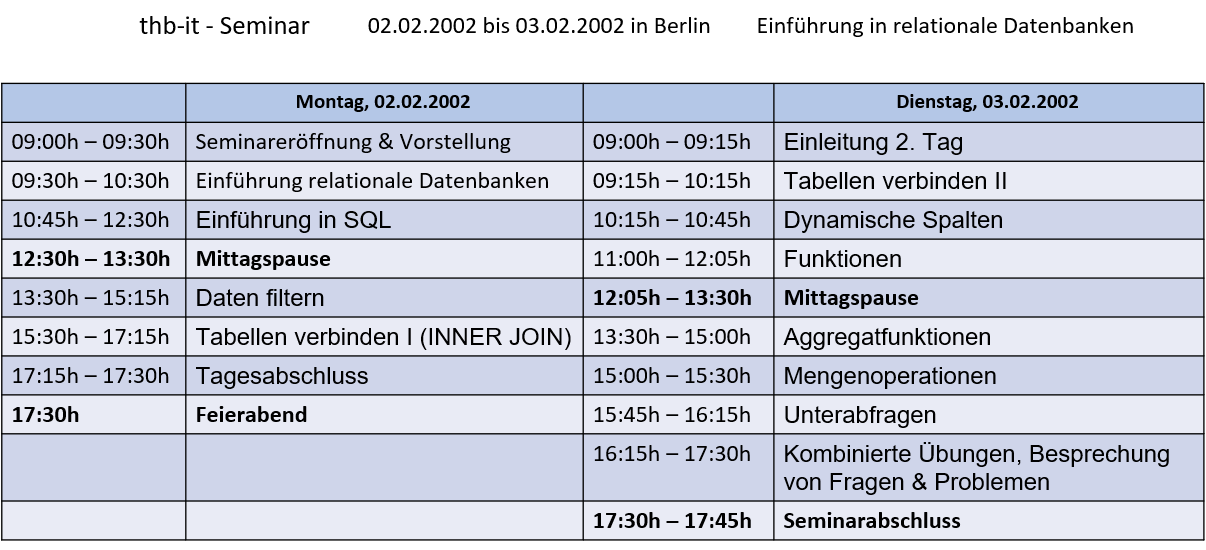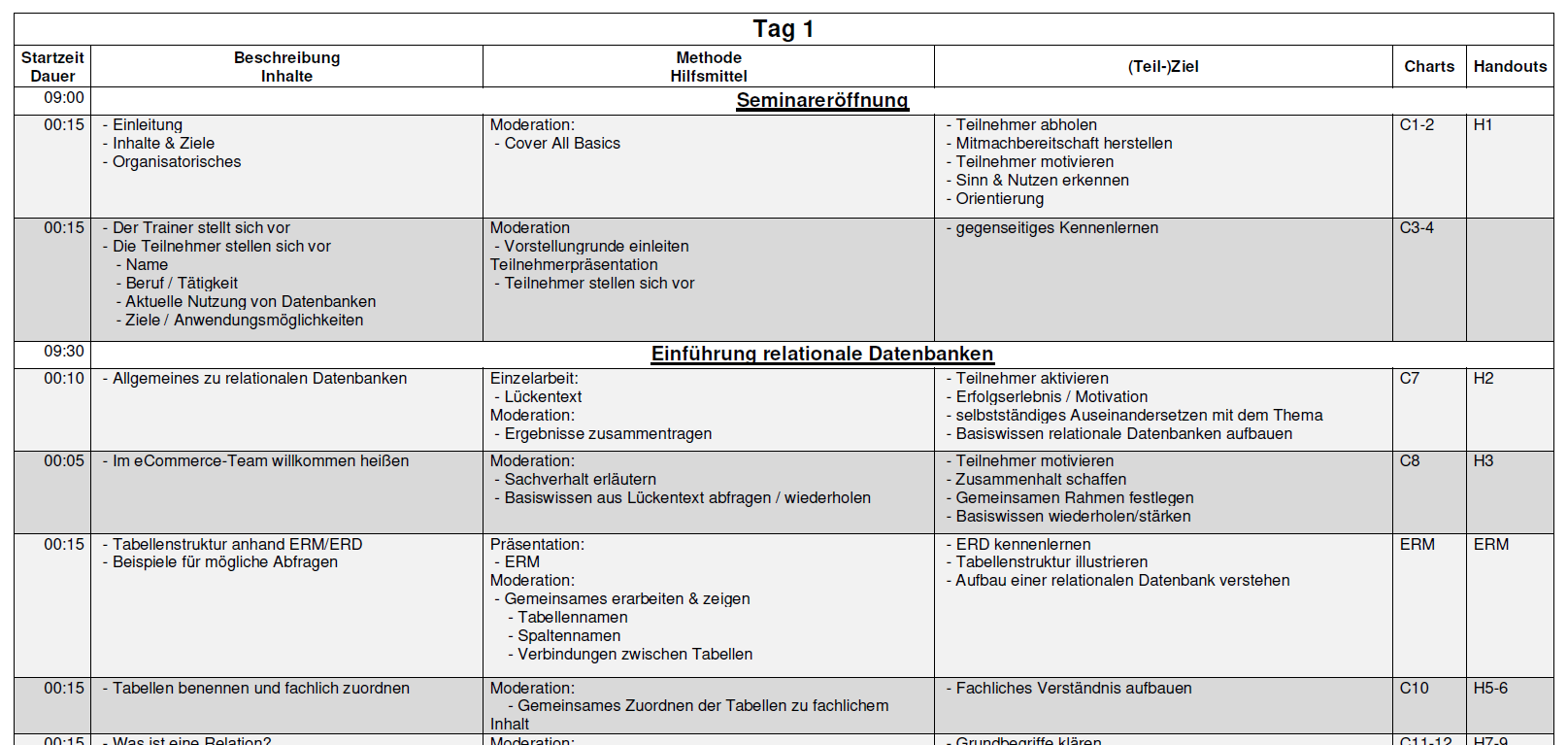Trainer Guide
10 steps to the perfect trainer guide

A trainer guide gives all participating trainers a detailed overview of the process and content of the seminar. In addition, it promotes understanding and leads to transparency. The trainer's guide helps the trainer to always keep track of things and to find their way around.
The benefits of creating a trainer guide are:
- Quality: By creating a trainer guide, the trainer is forced to deal with the training and the process in detail in advance. This can significantly increase the quality of the training.
- Orientation: By using the trainer's guide during training, the trainer always knows what the next steps are. This gives the trainer additional security. In addition, the trainer can see at a glance whether the group is achieving the expected learning success more quickly or more slowly and can adjust topics and/or methods accordingly.
- Adaptation / Optimization of the seminar: The trainer guide can be revised after each training session held to make the training session even more effective / engaging for participants.
- Multiple Trainers & Substitutes: If the training is to be carried out in a team or if the trainer needs a substitute, the trainer guide creates transparency and information about all parts of the training. So there are no misunderstandings about the content.
The components of a trainer's guide are:
- Cover sheet
- Main and sub-goals
- Rough timetable
- Number of participants
- Space requirements
- Equipment checklist and other requirements
- Start, end and break times
- Event description
- Handouts / Flipcharts / PowerPoint presentations etc.
- Substance plan
Cover Sheet
The trainer's guide should include a cover sheet with the logo, the name of the author(s), and the title of the seminar.
Main Goal Of The Event As Well As Sub-Goals
The goal of the seminar should be in the trainer's guide. Each sub-goal that the participants will achieve should also be noted. This underscores the structure and helps the trainer to orientate themselves more quickly and easily.
Rough Timetable
Durch die Erstellung eines Grobstoffplans wird die inhaltliche sowie zeitliche Planung des Trainings aggregiert nach Kernthemen übersichtlich visualisiert.

Number Of Participants
The number of participants is a decisive factor when planning a seminar. On the one hand, a minimum number of participants must be defined so that the seminar can be held in a meaningful way. A minimum number of participants will be required for certain group exercises or games.
On the other hand, a maximum number of participants must also be defined so that all participants can receive the best possible learning success. For example, it becomes difficult if not impossible to do justice to all participants to the same extent if it is a face-to-face seminar with 50 participants.
Space Requirements
The trainer also has to think carefully about the space requirements. The trainer should consider the following points:
- Size of the room: There should be enough space for all participants, the trainer, any equipment, seating arrangement, games, etc.
- Equipment of the room: For example, there should be sufficient sockets, if necessary a beamer, if necessary partitions, sufficient light, if necessary an additional table for the trainer, etc.
- Location of the room: The sanitary facilities should be easy to reach, if necessary there should be a corridor or a small room as a retreat (e.g. for group work), grocery stores should be in the immediate vicinity, infrastructure should be sufficiently developed (e.g. B. sufficient parking spaces nearby, motorway connection, train station, etc.)
Equipment Checklist And Other Requirements
It makes sense to create a checklist with all the necessary utensils in advance. For example, the following points could be included:
- camera
- projector
- cable reel
- microphone
- Laptop
- (digital) flipchart
- USB stick
- (special) pens
- spray glue
- posters
- partitions
- pictures
- Props for games and demonstrations (loudspeakers, balls, figures, etc.)
- possibly laptops for participants
- Sufficient handouts (depending on the number of participants)
- entry list
- etc.
Start, End And Break Times
The trainer should bring a time structure into the seminar schedule. This includes fixed start and end times as well as the (approximate) break times. The setting of the times serves as an orientation for the participants. Above all, it is important to end the seminar on time so that participants can catch their train or plane if necessary.
Event Description
The description of the seminar includes many of the points already explained. It is formulated as continuous text and is used to advertise the seminar on websites or in print media, for example.
Handouts / Flipcharts / PowerPoint Presentations
The handouts (information leaflets), flipcharts and/or PowerPoint presentations are also prepared as part of the guidelines.
Substance Plan
The fine material plan contains the individual detailed learning units. The following points are also noted in the fines plan:
- Time: planned start of the teach
- Duration: planned duration of the teach
- Description/Content: Explanation of the teach (topics and sub-topics)
- Method/tools: The method describes how the content is conveyed, e.g. B. moderation, presentation, individual work, group work, game, etc. Aids for conveying the content are z. g. cloze texts, flipchart, partition walls, ball, posters, etc.
- Handouts/Charts: References to or images of the handouts/charts in order to assign the respective teach to the handouts to be handed out or charts to be shown
- (Partial) goals: e.g. B. Motivating participants, creating a willingness to participate, activating participants, creating cohesion, defining a common framework, concrete learning goals, etc.

Conclusion
The creation of a trainer guide is basically optional, but recommended. In any case, the creation of a trainer's guide makes sense if the training is to be held several times or if several trainers will hold the training.
Even if the facilitator has to be substituted in the event of an unexpected absence, the trainer's guide is a helpful overview for the substitution.